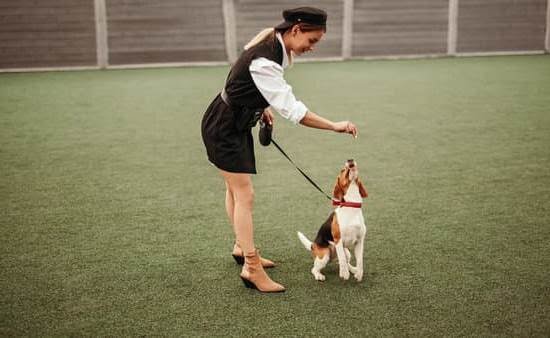Training dogs with buttons has become a popular and intriguing trend in the world of canine training. This unique method utilizes buttons that dogs can press to communicate their needs or desires. In this introductory section, we will explore the concept of training dogs with buttons, including its growing interest and background. By understanding this innovative approach, dog owners can unlock new possibilities for effective communication and bonding with their furry companions.
The use of buttons for communication with dogs has gained significant attention in recent years. Dog owners have been captivated by the idea of their pets being able to express themselves through a simple button press. This method allows dogs to communicate their wants, needs, or even answer questions using a set of specially-designed buttons. The fascination surrounding this concept has sparked interest among both pet owners and trainers alike.
While training dogs with buttons may seem like a relatively new phenomenon, it actually has a rich history. The use of visual symbols to communicate with animals dates back several decades. Over time, researchers and trainers have refined this technique, leading to the development of modern button training methods. By delving into the history and background of button training, we can gain insight into its effectiveness as a communication tool for dogs.
Understanding the concept and background of training dogs with buttons sets the stage for exploring its benefits and advantages in more detail. Through this innovative approach, we can tap into the potential impact on canine behavior and intelligence. By providing dogs with an intuitive way to communicate, owners can foster stronger relationships based on increased understanding and mutual respect. With these advantages in mind, let’s delve into how button training benefits both pet owners and their beloved furry friends.
Benefits and Advantages of Training Dogs with Buttons
Training dogs with buttons offers numerous benefits and advantages compared to traditional training methods. This section will delve into these advantages and highlight the positive impact of button training on canine behavior and intelligence.
Enhanced Communication
Using buttons allows dogs to communicate their needs, wants, or feelings more effectively. Instead of relying solely on body language or vocal cues, dogs can press specific buttons to convey a message. This enhanced communication leads to better understanding between humans and dogs, strengthening the bond and reducing frustration for both parties.
Cognitive Stimulation
Button training engages dogs mentally, stimulating their cognitive abilities in a unique way. By associating commands or requests with corresponding buttons, dogs learn to problem-solve and make connections between actions and outcomes. This mental stimulation is vital for their overall well-being, as it keeps their minds active and prevents boredom.
Empowerment and Independence
Button training empowers dogs by giving them a sense of control over their environment. When they can use buttons to communicate their needs or desires successfully, they become more independent and self-reliant. This newfound autonomy boosts their confidence levels and contributes to a happier, more fulfilled dog.
Language Development
Training dogs with buttons helps them develop language skills by associating words or phrases with corresponding symbols on the buttons. Dogs can understand human language better through this association process, expanding their comprehension beyond simple commands like “sit” or “stay.” This language development opens up avenues for more complex communication between humans and dogs.
Getting Started
To successfully train a dog with buttons, it is essential to have the right tools and materials. This section will provide a detailed list of necessary equipment and offer tips on choosing the right buttons and materials for successful button training.
One of the most crucial tools for button training is, of course, the buttons themselves. There are various options available in terms of shape, size, and material. Many trainers prefer using large, durable buttons that can withstand repeated pressing by dogs of all sizes and breeds. It is important to choose buttons that are easily distinguishable from one another so that dogs can clearly understand different commands or requests.
In addition to buttons, a button board or app is usually required for organizing and displaying the buttons. A button board typically consists of a sturdy surface with slots or compartments where the buttons can be placed. This allows dogs to easily press specific buttons to communicate their needs or respond to commands.
On the other hand, there are also smartphone apps available that simulate button boards digitally. These apps often come with features like recording custom commands or playing pre-recorded ones, making them versatile options for button training.
| Tools/Materials | Description |
|---|---|
| Buttons | Durable, large-sized buttons that are easily distinguishable from one another. |
| Button Board | A sturdy surface with slots or compartments for placing buttons. |
| Button Training App | A smartphone application that simulates a button board digitally. |
When selecting buttons and materials for button training, it is advisable to consider the individual preferences and needs of your dog. Some dogs may respond better to certain shapes or textures, so it may be worth experimenting with different options to find what works best for your furry companion. Additionally, ensure that all buttons and materials used are safe for dogs and do not pose any choking hazards.
By obtaining the necessary tools and materials for button training, you are setting yourself up for success in embarking on this innovative training method. In the next section, we will delve into teaching basic commands using buttons, providing a step-by-step guide to help you get started on your button training journey.
Teaching Basic Commands through Button Training
Button training can be an effective and engaging way to teach dogs basic commands. By associating specific buttons with different commands, you can create a clear and consistent method of communication with your furry friend. In this section, we will provide a step-by-step guide on introducing and teaching fundamental commands using buttons.
Step 1: Introduce the Buttons
The first step in button training is to introduce your dog to the buttons themselves. Start by placing a few buttons on a board or app that are labeled with the corresponding command, such as “sit” or “stay.” Encourage your dog to investigate the buttons by pawing at them or sniffing them. You may also use treats as positive reinforcement during this stage to associate the buttons with rewards.
Step 2: Establish Associations
Once your dog is comfortable with the buttons, it’s time to establish associations between the buttons and their corresponding commands. For example, every time you say “sit,” press the button labeled “sit.” Repeat this process several times until your dog starts to understand the connection between the word and button.
Step 3: Reinforce and Practice
Consistency is key when teaching basic commands through button training. Continually reinforce the association between each command and its respective button by consistently using them together. Gradually decrease your verbal cues while relying more on pressing the relevant button. Reward your dog for successfully following each command.
Practical examples of commands that can be taught through button training include “sit,” “stay,” and “come.” The process for teaching each command remains similar – using verbal cues initially while simultaneously introducing and associating them with their respective buttons.
With patience, practice, and repetition, your dog can become familiar with these basic commands through button training. Remember that every dog learns at their own pace, so be sure to tailor your training approach to suit your dog’s individual needs and learning style.
In the next section, we will delve deeper into understanding communication cues in button training, helping you decipher and interpret your dog’s pressing of buttons.
Understanding Communication Cues in Button Training
In button training, dogs learn to associate specific commands or requests with the corresponding buttons. This process involves teaching the dog to press a certain button to communicate their needs or desires effectively. Understanding how dogs learn these communication cues is essential for successful button training.
Dogs are highly perceptive animals and can quickly grasp the concept of associating buttons with specific commands. The key is consistency and repetition. When introducing a new command, such as “sit,” the trainer should consistently press the corresponding button while verbally reinforcing the command. Over time, the dog will start to associate that particular button with the action of sitting.
One helpful tip is to observe your dog’s behavior when they attempt to communicate through pressing buttons. Dogs may show signs of anticipation or frustration before pressing a certain button, indicating their desire for a particular action or request. For example, if your dog presses the “outside” button repeatedly while looking at you expectantly, it likely means they want to go outside.
To ensure effective communication through buttons, it’s crucial for trainers to be observant and responsive to their dogs’ cues. By carefully watching their actions and paying attention to which buttons they press in different situations, trainers can better understand their dogs’ wants and needs.
Furthermore, it’s important not to rely solely on buttons for communication but to continue using verbal cues as well. This helps reinforce the association between words and actions in a way that incorporates multiple forms of communication.
Overall, understanding communication cues in button training is about developing a deeper bond and level of understanding between trainers and their canine companions. By observing and deciphering a dog’s communication through button pressing, trainers can respond appropriately and strengthen the effectiveness of this innovative training method.
| Button | Command |
|---|---|
| Bathroom | Go outside to relieve themselves |
| Play | Initiate playtime |
| Water | Request water or access to water source |
| Treat | Request a treat as a reward |
Troubleshooting and Common Challenges in Button Training
Training dogs with buttons can be a highly effective and rewarding experience for both the dog and their owner. However, like any training method, it is not without its challenges. In this section, we will explore some common hurdles that may arise during button training and provide strategies for overcoming them.
- Lack of Response: One common challenge in button training is when the dog does not respond to pressing the buttons. This could be due to various reasons such as confusion or lack of motivation. To address this issue, it is important to ensure that the dog understands the cause-effect relationship between pressing a button and getting a desired outcome.
Start by reinforcing simple commands they already know using traditional methods before transitioning to the buttons. Additionally, make sure you are using high-value rewards such as treats or toys to motivate your dog. - Overgeneralization: Overgeneralization occurs when a dog starts associating all buttons with one command or request. For example, if your dog associates pressing any button with getting a treat, they may start pressing random buttons without understanding their specific meanings. To avoid this, introduce new commands gradually and involve clear cues or gestures along with button pressing to help your dog differentiate between different commands.
- Button Fatigue: Dogs may become fatigued from excessive training sessions involving the buttons, leading to disinterest or unwillingness to participate in further training sessions. To prevent button fatigue, keep training sessions short and focused, around 5-10 minutes, depending on your dog’s attention span and energy levels. It is also crucial to mix up the training routine by incorporating other forms of mental stimulation and physical exercise.
- Environmental Distractions: Another challenge in button training is environmental distractions that can divert your dog’s attention away from the buttons. This could include noises from outside, other pets or people in the household, or external stimuli like birds or squirrels.
To minimize distractions, choose a quiet and familiar location for training sessions, gradually increasing the level of distractions as your dog progresses in their training. Using earplugs to reduce external noises may also help your dog focus better on the buttons.
By being aware of these common challenges and implementing the suggested strategies, you can overcome obstacles in button training and create a successful learning experience for your canine companion. Remember, patience, consistency, and positive reinforcement are key elements in achieving effective communication and understanding between you and your four-legged friend. Keep practicing, stay determined, and enjoy the journey of unlocking the potential of button training.
Advanced Button Training Techniques
Once your dog has mastered the basic commands through button training, you may be interested in taking their training to the next level with advanced techniques. Advanced button training introduces more complex commands and tricks that can impress and entertain both you and your furry friend. Here are some step-by-step instructions for teaching advanced commands through button training.
One of the first advanced commands you can teach your dog is “fetch.” To begin, introduce a button with a picture or word symbolizing “fetch” on it. When you press the “fetch” button, make sure to throw a toy or object for your dog to retrieve.
After several repetitions of pressing the “fetch” button followed by throwing the toy, encourage your dog to press the button themselves before retrieving the toy. Provide lots of praise and rewards when they successfully press the correct button.
Another impressive command that can be taught through button training is “roll over.” Start by introducing a new button with a symbol representing “roll over.” Simultaneously, guide your dog into a lying down position.
Once they are lying down, gently guide them onto their side and then continue guiding them until they complete one full roll-over motion. As you guide them, reinforce the action by pressing the “roll over” button each time. Eventually, your dog will associate the action of rolling over with the command represented by the button.
For those looking to add some flair to their training routine, teaching your dog to play dead is a great option. Begin by introducing a new button with a symbol or word representing “play dead.” Guide your dog into a lying down position as if doing a regular lay down command, but this time give an extra cue for them to stay completely still.
As they remain still, reinforce the behavior by pressing the “play dead” button and providing rewards. Over time, increase the duration of them staying still before releasing them from the command.
Remember that patience and consistency are key when teaching your dog advanced button training techniques. Break down each command into smaller steps, and always reward your furry friend for progress and success. With practice, you’ll be amazed at the complex tricks and commands your dog can learn through button training.
Continue exploring advanced button training techniques to strengthen the bond with your dog and challenge their mental capabilities. The possibilities are endless, and the satisfaction of teaching your dog impressive commands is rewarding for both of you. Have fun and enjoy the journey as you unleash the potential of advanced button training with your canine companion.
Maintaining and Reinforcing Button Training
Once you have successfully trained your dog to understand and respond to commands through button training, it is important to maintain and reinforce their training to ensure long-term success. Consistency is key in any form of dog training, including button training. Here are some tips for maintaining and reinforcing button training with your furry companion.
Firstly, it is crucial to continue practicing button training on a regular basis. Consistent practice will strengthen the bond between you and your dog, as well as reinforce the learned commands. Set aside dedicated time each day for training sessions with your dog and make it a fun and engaging experience for them.
Additionally, make sure that the buttons or communication tools are easily accessible to your dog at all times. Place them in a prominent location within your home so that they can easily approach and press the appropriate button when needed. It’s important not to move the buttons around too much as this can confuse your dog.
During your practice sessions, continue to reward and reinforce correct responses from your dog. Positive reinforcement is a powerful tool in maintaining their understanding and motivation. Whether it’s treats, praise, or playtime, use rewards that your dog finds most appealing.
In order to avoid confusion or mixing up of commands, be consistent with the placement of buttons when teaching new commands or revisiting previously trained ones. For example, if you initially used one particular button for “sit,” continue using that same button for that command instead of introducing a different one.
It can also be beneficial to periodically assess your dog’s progress in button training by introducing new challenges or reviewing previously learned commands. This not only maintains their skills but also keeps them mentally stimulated and engaged in the training process.
Remember that every dog is unique and may require different levels of reinforcement and maintenance. Pay attention to how effectively they are responding to their button commands over time and adjust your approach accordingly.
By consistently practicing button training techniques, providing clear communication tools, and reinforcing commands, you are setting your dog up for continued success in their training journey. The bond and understanding between you and your furry companion will grow stronger as you explore the potential of button training together.
Real-Life Success Stories
An Inspiring Journey of Communication and Connection
Training dogs with buttons has gained popularity due to the remarkable success stories of real-life case studies. These heartwarming tales demonstrate the power of button training in fostering communication, understanding, and connection between humans and their furry companions. Let’s explore some inspiring examples:
Luna: The Communicative Corgi
Luna, a Pembroke Welsh Corgi, captured the hearts of many when she became an internet sensation for her impressive button training skills. Her owner, Lisa, diligently taught her a wide range of commands using buttons and documented their progress on social media. Through consistent training sessions and positive reinforcement, Luna quickly learned to communicate her desires and needs through the buttons.
One of Luna’s most memorable achievements was her ability to request specific toys by pressing corresponding buttons. By pressing the appropriate sequence of buttons, she could indicate which toy she wanted to play with at that moment. This not only showcased her intelligence but also strengthened the bond between Luna and Lisa as they engaged in meaningful interactions.
Bailey: From Reactive to Responsive
Bailey, a rescue dog with a troubled past, experienced significant behavioral improvement through button training. When Maggie adopted Bailey, he struggled with anxiety and reactive behavior towards other dogs. However, by incorporating button training into his routine, Maggie provided Bailey with an effective outlet for communication.
With time and patience, Bailey began associating specific buttons with emotions like fear or excitement. Whenever he encountered trigger situations or felt overwhelmed, he learned to press the appropriate button to express his discomfort or need for space. This newfound ability allowed him to feel understood while enabling Maggie to provide him with the necessary support.
The Impact and Potential of Button Training
These real-life success stories represent just a glimpse of the transformative power of button training in improving the lives of dogs and their owners. The use of buttons enables dogs to articulate their thoughts, feelings, and desires in a way that was previously not possible. This new means of communication strengthens the bond between humans and dogs, deepening trust and enhancing overall well-being.
By sharing these stories, we hope to inspire dog owners to explore button training and discover the incredible potential it holds for their own four-legged companions. With dedication, patience, and a willingness to learn together, both humans and dogs can unlock a whole new level of understanding and connection through this innovative training method.
Conclusion
In conclusion, button training has emerged as an innovative and effective method for training dogs, offering numerous benefits and opportunities for both canine and human companions. Through the use of buttons, dogs are able to communicate their needs and desires in a clear and understandable way, leading to improved behavior and enhanced intelligence. The growing trend in button training reflects a shift towards more holistic approaches to dog training that prioritize mental stimulation and communication.
One of the key advantages of button training is its ability to foster better communication between dogs and their owners. By associating specific buttons with commands or requests, dogs can effectively convey their thoughts or needs. This not only strengthens the bond between humans and dogs but also enhances the overall understanding of each other’s actions and intentions.
Furthermore, button training offers a unique opportunity for mental stimulation for our furry friends. By learning how to press different buttons to express themselves, dogs engage in critical thinking processes that enhance their problem-solving skills. This mental exercise contributes to a more intelligent dog who is better equipped to navigate various situations.
It is important for readers to explore the potential of button training as a tool for enhancing their bond with their beloved pets. By giving our dogs the means to communicate effectively through buttons, we unlock their true potential for understanding and being understood. Additionally, this training method provides an enriching experience that stimulates their cognitive abilities, resulting in happier and healthier canine companions.
So why not give it a try? Embark on this journey of exploration with your four-legged friend and unlock a whole new level of connection through button training.
Frequently Asked Questions
How do you train dogs to use buttons?
Training a dog to use buttons involves a step-by-step approach that requires consistency, patience, and positive reinforcement. To start, select a set of buttons with different symbols or words corresponding to actions or objects the dog might want or need. Next, introduce the buttons to the dog by associating each button with a specific action, such as pressing the button when going outside.
This can be done by highlighting the action while simultaneously pressing the associated button and providing treats or praise. With repeated practice and reinforcement, the goal is for the dog to associate each button with its corresponding meaning and learn how to communicate their desires by independently using the buttons.
How long does it take to train a dog to use buttons to talk?
The time it takes to train a dog to use buttons varies depending on factors such as the individual dog’s intelligence, temperament, and previous training experience. Generally, it can take anywhere from a few weeks to several months of consistent training sessions for a dog to become proficient in using buttons for communication purposes.
Consistency is key in this training process; frequent practice sessions and everyday use of the buttons help reinforce learning and solidify understanding. Additionally, some dogs may naturally pick up on this skill more quickly than others due to their ability to make connections and understand cause-and-effect relationships.
Is it hard to teach dogs to use buttons?
Teaching dogs to use buttons can be a challenging task but not necessarily hard if approached with patience, consistency, and positive reinforcement techniques. As with any form of training, some dogs may require more time and repetition than others before fully grasping the concept of using buttons for communication purposes. It is important for pet owners or trainers not to get discouraged if progress seems slow initially.
By breaking down the training process into small steps and gradually building upon them as the dog learns, it becomes easier for the dog to understand what is expected from them when interacting with the buttons. Additionally, implementing rewards like treats or verbal praise whenever they successfully use a button helps motivate dogs during their learning journey.

Welcome to the blog! I am a professional dog trainer and have been working with dogs for many years. In this blog, I will be discussing various topics related to dog training, including tips, tricks, and advice. I hope you find this information helpful and informative. Thanks for reading!





